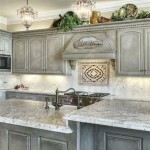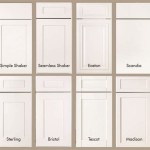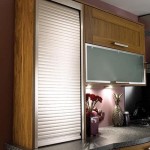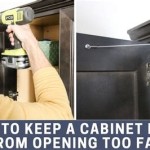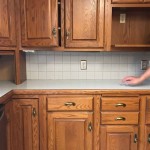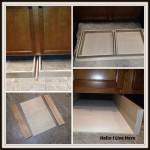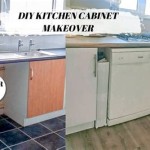Kitchen Cabinet Backplates: Functionality, Aesthetics, and Installation
Kitchen cabinet backplates, often overlooked in the grand scheme of kitchen design, play a crucial role in both the functionality and aesthetics of cabinetry. These small but significant components, installed behind cabinet knobs or pulls, serve multiple purposes, from protecting the cabinet surface to enhancing the overall visual appeal of the kitchen.
The selection of appropriate backplates requires careful consideration of various factors, including cabinet style, hardware finish, and personal preferences. A well-chosen backplate can elevate the appearance of even the simplest cabinets, while a poorly chosen one can detract from the kitchen's overall design.
Protection and Durability
One of the primary functions of a kitchen cabinet backplate is to protect the cabinet surface from damage. Over time, the repeated use of cabinet hardware can lead to scratches, dents, and wear around the mounting area. Backplates act as a barrier, distributing the pressure and preventing direct contact between the hardware and the cabinet's finish. This is particularly important for cabinets with delicate finishes or those made from softer materials.
The protective function extends beyond superficial damage. Backplates also help prevent the screws securing the hardware from loosening over time. The larger surface area of the backplate provides a more stable anchor point, reducing the likelihood of the hardware becoming wobbly or detaching completely. This is especially crucial in high-traffic areas like kitchens, where cabinet doors and drawers are frequently opened and closed.
Furthermore, backplates can conceal existing damage around the hardware mounting area. If a previous set of hardware left unsightly marks or scratches, a backplate can effectively cover these imperfections, providing a clean and polished look without the need for extensive cabinet repair or refinishing. This makes backplates a cost-effective solution for updating the appearance of older cabinets.
Aesthetic Enhancement and Style
Beyond their protective function, kitchen cabinet backplates offer significant aesthetic benefits. They can enhance the overall style of the kitchen by adding visual interest and complementing the existing design elements. The wide variety of shapes, sizes, finishes, and materials available allows for customization to suit any kitchen aesthetic, from traditional to contemporary.
For example, a kitchen with Shaker-style cabinets might benefit from rectangular or square backplates with clean lines, while a more ornate kitchen could use backplates with intricate detailing or decorative edges. The finish of the backplate should ideally match or complement the cabinet hardware to create a cohesive look. Options range from classic finishes like brushed nickel and polished chrome to more rustic options like oil-rubbed bronze and antique brass.
Backplates can also be used to create contrast and visual interest. For instance, a dark cabinet with light-colored hardware can be paired with a light-colored backplate to create a striking contrast. Similarly, a metallic backplate can add a touch of glamour to a matte cabinet finish. The possibilities are endless, allowing homeowners to express their personal style and create a unique kitchen design.
The size and shape of the backplate are also important considerations. Larger backplates can make a bolder statement and are often used with larger cabinet pulls, while smaller backplates are more subtle and may be better suited for smaller knobs. Round backplates offer a softer, more traditional look, while square or rectangular backplates provide a more modern and geometric feel.
Installation and Practical Considerations
The installation of kitchen cabinet backplates is generally a straightforward process, but careful attention to detail is essential to ensure a professional and secure result. The first step is to select the appropriate backplate size and shape for the existing hardware and cabinet style. It is also important to consider the thickness of the cabinet door or drawer front to ensure that the screws provided with the hardware are the correct length.
Before installing the backplate, it is advisable to clean the cabinet surface thoroughly to remove any dirt or grease. This will ensure a good bond between the backplate and the cabinet. If the backplate has an adhesive backing, carefully peel off the protective film and position the backplate in the desired location. Press firmly to ensure that the adhesive adheres properly to the cabinet surface.
For backplates without adhesive backing, it may be necessary to use small screws or nails to secure them to the cabinet. In this case, it is important to pre-drill pilot holes to prevent the wood from splitting. The pilot holes should be slightly smaller than the diameter of the screws or nails being used. Position the backplate and then carefully drive the screws or nails into the pilot holes, making sure not to overtighten them.
When replacing existing hardware with backplates, it is important to ensure that the new backplate covers any existing screw holes or damage. If the holes are visible, they can be filled with wood filler and sanded smooth before installing the new backplate. This will create a seamless and professional-looking finish.
Finally, it is essential to choose backplates made from durable and high-quality materials. Common materials include stainless steel, brass, bronze, and zinc alloy. Stainless steel is a popular choice due to its corrosion resistance and durability, while brass and bronze offer a more traditional and elegant look. Zinc alloy is a cost-effective option but may not be as durable as other materials. The selection of material depends on the budget, aesthetic preferences, and the level of wear and tear the cabinets are expected to endure.
The selection of the correct size is also key. Backplates which are too small may fail to adequately protect the cabinet finish from wear and tear. Likewise, backplates which are too large may look clumsy and out of place on the cabinet.
Ultimately, the choice of kitchen cabinet backplates is a personal one, guided by individual aesthetic preferences and the overall design of the kitchen. However, by considering factors such as protection, style, installation, and material, homeowners can select backplates that not only enhance the appearance of their cabinets but also provide long-lasting protection and durability.

Amerock Backplates 3 In 76 Mm Oil Rubbed Broe Drawer Pull Backplate Bp19208orb The Home Depot

Perles Drawer Pull With Rounded Rectangle Backplate Rejuvenation

Richelieu Hardware Tremblant Collection 3 4 In 96 Mm Oil Rubbed Broe Transitional Cabinet Backplate For Pull Bp104596borb The Home Depot

Channing Cabinet Knob And Backplate San Diego Hardware

Gliderite 2 1 In Satin Nickel Round Classic Cabinet Knob Backplate 10 Pack 5060 Sn The Home Depot

Jeffrey Alexander Cabinet Pull Backplate Van Dyke S Rers

Gliderite 1 2 In Antique Brass Round Thin Classic Cabinet Knob Backplate 10 Pack 5061 Ab The Home Depot

Top Knobs M1466 Solid Broe Cabinet Knob Backplate Aspen Series Light Finish 1 3 4 Dia Decorative Hardware Door Shutter Window Bath Architectural Accessories

Cosmas B 112sn Satin Nickel Cabinet Hardware Knob Backplate Back Plate 50 Pack Com

Channing Cabinet Knob And Backplate San Diego Hardware
Related Posts

